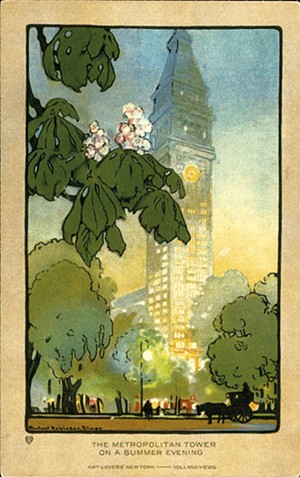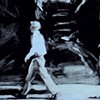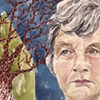Published July 9, 2014 at 10:59 a.m.
The Rokeby Museum in Ferrisburgh was once home to several generations of the Robinson family, from the late 18th century until the place became a museum in 1961. Even Vermonters who have never been there likely know that the homestead was an integral part of the Underground Railroad — a refuge for fugitive slaves well before the Civil War. In fact, the Rokeby recently won national honors for its fascinating multimedia installation "Free & Safe: The Underground Railroad in Vermont."
Aside from being Quakers and abolitionists, the Robinson clan also produced several artists. The last of them, Rachael Robinson Elmer (1878-1919), is now the focus of an exhibit at the Rokeby. Showing "Rachael's New York Postcards at 100" would not have been possible before the construction of the museum's education center last year. The new building includes a roomy and well-lit gallery space, which offers Rokeby director Jane Williamson the opportunity to excavate and display more of the trove of ephemera stored at the museum. The Robinsons were pack rats who saved everything, she notes in an essay on the museum's website, and among the boxes were records and reproductions of Elmer's artwork.
The current exhibit consists of a dozen postcards and one original painting, along with a few sepia-toned photographs of New York City in the early 1900s. All the postcards are gauzy watercolor scenes, bordered in black ink, of significant sights around Elmer's beloved Manhattan: the New York Public Library; the Singer Building, seen from the Brooklyn Bridge; New York seen from the 34th Street ferry; the Washington Arch in winter; the Cathedral of St. John the Divine and more.
The paintings are competent and evocative, and reveal the talent that Elmer's parents saw in her from childhood. Rowland E. Robinson and Ann Stevens Robinson were artists, too; they sent young Rachael to New York to study art at age 14. After she graduated from high school in Vermont, she soon returned to the city. Rachael spent three years with the Art Students League, studying with the American impressionist painter Childe Hassam and others; she settled in New York around 1900 and found work as an illustrator and graphic artist, working primarily for prominent publishers.
In 1911, Rachael Robinson met and married businessman Robert Elmer. According to the Rokeby, the couple had no children but did have "something of an egalitarian marriage." Translation: She continued her career.
Had she not done so, these postcards would likely not exist. What's the big deal about pretty postcards? In America before 1914, reproducing paintings in this format was unheard of. As the exhibit's wall text explains, Elmer had seen three "lovely pastels of London" on postcards in 1911 (these are on view, as well) and was inspired to create similar fine-art cards — featuring New York — on this side of the pond. It was a hard sell to persuade anyone to produce them, but Chicago publisher Paul Volland eventually responded to Elmer in 1914, and she was suddenly "up to my ears in work," as she wrote in a letter home.
The 12 scenes were painted and reproduced as "Art-Lovers' New York" postcards that year. And they quickly became all the rage. The New York Sun extolled Elmer's images in a full-page story. Similar cards "were immediately copied by dozens of artists in New York and elsewhere," notes Williamson.
Now, a century later, Elmer's postcards are highly collectible. But it's rare, Williamson says, for anyone to acquire a full set. Contemporary postcard fans now have that opportunity: In honor of the exhibit, the Rokeby had reproductions made of all 12 cards — both sides — and is selling them in packets for a modest $9.
The one original painting in the exhibit, which Williamson found in a box at the museum and "realized what it was," is an image Volland rejected. It's a springtime scene of New York City Hall, with the grand, ornate Municipal Building — then brand new — looming in the back. Why the publisher didn't want this painting is a mystery; it's every bit as pretty as the others.
Nor can we ever know where Rachael Robinson Elmer's talent might have led her: She died in the Spanish flu epidemic in 1919, at the age of 40.
INFO
"Rachael's New York Postcards at 100," Rokeby Museum, Ferrisburgh, through October 26. rokeby.org
The original print version of this article was headlined "Postcards From the Past"
More By This Author
Speaking of Rokeby Museum
-

New Rokeby Exhibit Showcases Works by Imprisoned Artists
Aug 23, 2023 -

Rokeby Museum Supporters Bake Pies and Share Tips Ahead of a Ferrisburgh Fundraiser
Aug 8, 2023 -

Rokeby Museum in Ferrisburgh Re-Creates 19th-Century Séances
Oct 27, 2021 -

It’s the Season of Charitable Bake Sales to Satisfy Your Sweet Tooth
Jul 13, 2021 -

Vermont Museum Leaders Reflect on the Past and Pandemic Present to Rethink the Future
Mar 3, 2021 - More »
Comments
Comments are closed.
From 2014-2020, Seven Days allowed readers to comment on all stories posted on our website. While we've appreciated the suggestions and insights, right now Seven Days is prioritizing our core mission — producing high-quality, responsible local journalism — over moderating online debates between readers.
To criticize, correct or praise our reporting, please send us a letter to the editor or send us a tip. We’ll check it out and report the results.
Online comments may return when we have better tech tools for managing them. Thanks for reading.















































